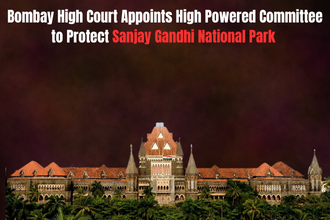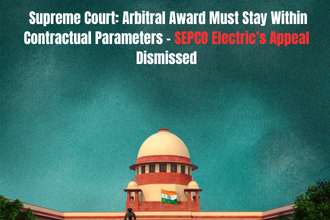The Bombay High Court has recently taken a significant step to safeguard the Sanjay Gandhi National Park (SGNP) by constituting a High Powered Committee under the Chairmanship of former Allahabad High Court Chief Justice Dilip Babasaheb Bhosale. This decision, issued in the matter of Samyak Janhit Seva Sanstha v. The Union of India, underscores the judiciary’s proactive role in environmental conservation and protecting urban green spaces against encroachment.
Background of the Case
The case originated from a contempt of court petition alleging non-compliance with earlier orders passed in a writ petition filed in 1995. The writ petition had sought to ensure the protection and preservation of SGNP, a critical ecological zone spanning Mumbai and Thane. Despite multiple judicial directives over the past three decades, the State Government had not effectively implemented measures to safeguard the park.
Recognizing the urgency and gravity of the matter, the Division Bench of Chief Justice Shree Chandrasekhar and Justice Gautam A Ankhad passed an order to constitute a High Powered Committee. The bench highlighted the importance of SGNP as a “crown jewel” for the cities of Mumbai and Thane and stressed the need for structured steps to prevent further environmental degradation.
Composition of the High Powered Committee
The committee is chaired by Justice Dilip Babasaheb Bhosale, with remuneration of ₹1 lakh per sitting. Other members of the committee, receiving ₹55,000 per sitting, include:
- Nitin Kareer – Former Chief Secretary of Maharashtra
- Subodhkumar Jaiswal – Former Director General of Police, Maharashtra
- Anita Patil – Conservator of Forests and Director of Sanjay Gandhi National Park, Borivali
The committee’s diverse composition ensures that administrative, law enforcement, and ecological expertise are brought together to address the complex challenges facing SGNP.
Mandate and Functions of the Committee
The High Powered Committee has been entrusted with a broad mandate to protect and preserve SGNP. Its primary functions include:
- Boundary Wall Construction: Ensuring the construction of a comprehensive boundary wall along the park limits to prevent encroachments.
- Compliance with Court Orders: Suggesting measures for the effective implementation of all judicial orders concerning SGNP.
- Rehabilitation of Encroachers: Identifying lands, planning, constructing, and funding rehabilitation tenements for individuals residing illegally within the park.
- Coordination with Agencies: Gathering inputs from relevant authorities for efficient execution of rehabilitation and encroachment removal plans.
- Removal of Encroachments: Overseeing the removal of unauthorized structures and settlements within the park.
- Reporting to the Court: Submitting detailed reports on pending interim applications and matters related to park management, after consulting all concerned parties.
Court’s Directives to the State Government
The Bombay High Court directed the State Government to fully cooperate with the committee. This includes providing office space, vehicles, secretarial and police support, and other necessary infrastructure. The Court further warned that any failure to assist the committee or disobedience of its directives could lead to contempt proceedings.
The Court also emphasized transparency, instructing the State Government to publish details of the committee, its meetings, and, where appropriate, the minutes of such meetings on official websites. This approach aims to keep all stakeholders, including the public, informed about the committee’s progress and initiatives.
Context and Urgency
The petitioners highlighted that nearly thirty years had passed since the filing of the original plea, and despite multiple judicial orders since 1997, the State had not taken effective measures for SGNP’s protection. Encroachments continued, and prior rehabilitation plans for displaced occupants had not been fully implemented.
In response, Advocate General Dr. Birendra Saraf assured the Court that the State was actively taking steps to comply with prior judicial orders. He confirmed that out of 90 acres designated for rehabilitation, approximately 44 acres would be immediately available for residential development. The remaining 46 acres would soon be processed, provided the land was not included in the final notification as forest area.
Judicial Oversight and Timeline
The High Powered Committee has been mandated to submit its first report to the Bombay High Court within three months from its initial meeting. The matter is scheduled for further hearing on February 19, 2026.
Justice Chandrasekhar and Justice Ankhad appreciated the proactive role of Advocate General Dr. Saraf in facilitating the committee’s constitution. The Court reiterated the importance of timely action and effective monitoring to prevent further encroachments and preserve SGNP.
Legal Representation
The contempt petition was represented by Senior Advocate Janak Dwarkadas and advocate Namrata Vinod for the petitioners. Advocates Hemant Ghadigaonkar, Sandesh More, and Hitendra Gandhi represented the petitioners in the 2023 Public Interest Litigation (PIL). Intervenors were represented by Advocates Vishal Kanade and Biswadeep Chakravarty. The State was represented by Advocate General Dr. Birendra Saraf, assisted by Assistant Government Pleader Prashant Kamble.
Significance of the High Powered Committee
The establishment of the High Powered Committee reflects the judiciary’s commitment to environmental protection and urban ecology. Sanjay Gandhi National Park is one of Mumbai’s last green lungs and plays a crucial role in biodiversity conservation, groundwater recharge, and maintaining ecological balance.
By creating a dedicated oversight mechanism, the Bombay High Court ensures that:
- Encroachments are systematically removed
- Rehabilitation of affected occupants is handled efficiently
- Compliance with judicial orders is enforced
- Coordination among multiple governmental and non-governmental agencies is streamlined
Environmental and Public Impact
SGNP is home to diverse flora and fauna, including several endangered species. Unchecked encroachments and illegal constructions can severely threaten this fragile ecosystem. The Court’s initiative highlights the intersection of environmental law, public interest litigation, and effective administrative oversight.
Moreover, the active involvement of senior bureaucrats and former law enforcement officials ensures practical, on-ground enforcement, while the chairmanship of a former Chief Justice adds legal oversight, reinforcing accountability.
Conclusion
The Bombay High Court’s decision to constitute a High Powered Committee underlines the judiciary’s proactive role in environmental conservation. The committee’s mandate ensures protection of Sanjay Gandhi National Park, addresses illegal encroachments, and emphasizes rehabilitation and compliance with court orders.
This initiative serves as a benchmark for urban environmental governance in India, balancing ecological preservation with the rights of residents, and reinforces the principle that judicial intervention can catalyze effective administrative action for public interest causes.
The coming months will be critical in assessing the committee’s performance and its ability to ensure that SGNP remains a protected ecological space for generations to come.
Also Read
Delhi High Court Restrains Use of ‘WOW BURGER’, Upholds WOW Momo’s Trademark Rights



